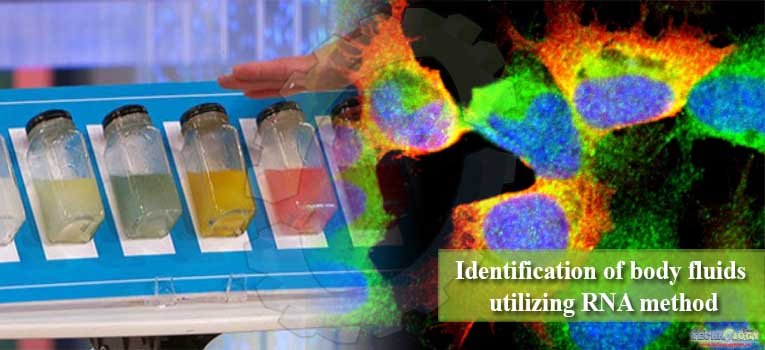The finding and recognition of body fluids at a crime scene are very important features of forensic science utilizing RNA methods.
 Determining whether or not there is a body fluid present and eventually recognized it allows the sample to undergo further laboratory testing including DNA analysis which is a very crucial step in a wide range of investigations.
Determining whether or not there is a body fluid present and eventually recognized it allows the sample to undergo further laboratory testing including DNA analysis which is a very crucial step in a wide range of investigations.
The most frequent body fluids found at crime scenes are blood, semen, and saliva, but others such as vaginal fluid, urine, and sweat can also play important roles including the impact of valuable DNA evidence.
Current developments in forensic genetics have proceed to the development of numerous new methods, and the excess of these methods involve the detection of specific messenger RNA (mRNA) and micro RNA (miRNA) expressions, as well as differential DNA methylation patterns.
Particularly, current methods based on tissue-specific mRNA or miRNA expression have been verified to be useful because of their high tissue specificity to forensically related body fluids.
However, ever-present ribonucleases are harmful to mRNA stability, and RNA typing requires additional sample material, unless the RNA is co-extracted with DNA.
More recently, DNA-methylation based assays, which identify differential DNA methylation profiles of different cell or tissue types, have been proposed as a promising new method for differentiate between different types of body fluids because of their high specificity and fit with current forensic casework application.
In 2005 two scientist Juusola and Ballantyne used a multiplex RT-PCR method for the recognition of body fluids and they were able to identify each of the four body fluids as single or mixed stains.
In 2007 Juusola and Ballantyne reported multiplex (qRT-PCR) method for the recognition of blood in which body fluid-specific genes were used for saliva and semen, but blood specific marker PBGD was exchanged with δ-aminolevulinate synthase 2 (ALAS2) and housekeeping gene GAPDH was established for the normalization of the expression of body fluid-specific genes.
Nussbaumer et al. also reported multiplex qRT-PCR assays, which include hemoglobin A (HBA) for blood and HBA mRNA was highly expressed in all blood samples screened, but some of the saliva samples also showed a weak reaction.
Haas et al. described a multiplex RT-PCR and a multiplex qRT-PCR for the recognition of blood, saliva,by using RNA markers. The two developed multiplex RT-PCRs presented high specificity, sensitivity and suitability for forensic body fluid analysis, and mRNA stability was confirmed for up to 2-year-old stains. Fleming and Harbison proposed improving the mRNA multiplex system for body fluid identification by applying microbial markers.
microRNA (miRNA) markers used as a revolutionary tool for forensic body fluid recognition because humidity and temperature are considered to effect mRNA stability. MiRNAs are non-coding RNA molecules of 18 to 22 nucleotides in length, and adjust gene expression at the post-transcriptional level.
Hanson et al. proved that miRNA can be extracted from forensic samples using qRT-PCR analysis. Zubakov et al. used genome-wide microarray to profile the expression level of miRNAs.
Although these two initial studies presented the potential of miRNA profiling for forensic investigation, their results were unpredictable when different technology platforms and statistical methods were applied.
DNA methylation, which occurs at the 5′-position of the pyrimidine ring of cytosine in CpG dinucleotides, is usually believed to inhibit gene expression by affecting chromatin structure. Different cell types have different methylation patterns, and chromosome segments called tissue-specific differentially methylated regions (tDMRs).
In 2011, Frumkin et al. applied an assay for selected markers using methylation-sensitive restriction enzyme-PCR (MSRE-PCR) made up of methylation-sensitive restriction enzyme digestion of sample DNA followed by multiplex PCR of specific genomic loci with fluorescence-labeled primers, capillary electrophoresis of amplification products and automatic signal detection.
Later, Wasserstrom et al. advanced the previously reported approach which is based upon the detection of semen-specific DNA methylation patterns in five genomic loci using MSRE-PCR.
Lee et al. also observed the potential of tDMRs for forensic body fluid identification using a bisulfite sequencing method. Bisulfite sequencing determines the DNA methylation by detection of nucleotide base change due to sodium bisulfite treatment.
Bisulfite treatment has no influence on methylated cytosine, but converts free or unmethylated cytosine to uracil, which becomes thymine during subsequent PCR. The tDMRs for DACT1 and USP49 were selected as a semen-specific marker by showing semen-specific hypomethylation, and the PFN3 tDMR was suggested to be used for vaginal fluid identification.
Madi et al. also reported tissue-specific DNA methylation in forensically relevant biological samples including blood, saliva, semen and epithelial cells.
They examined a few genomic loci using bisulfite modification and pyrosequencing to find that the methylation patterns at the ZC3H12D and FGF7 loci can differentiate sperm from other biological samples while the C20 or F117 locus and the BCAS4 locus can differentiate blood and saliva from other samples, respectively.
These results also indicate that the DNA methylation-based methods could be a valuable analysis tools for the characterization of forensically relevant biological fluids.
mRNA markers have been most thoroughly examined. mRNA markers display high tissue-specificity and acceptable sensitivity for forensic analysis. Recently, DNA methylation profiling was proposed as a promising new tool for forensic body fluid identification, which uses the same DNA samples which are used for DNA typing.
Like mRNA profiling methods, DNA methylation profiling showed high specificity and sensitivity, and also allowed for the simultaneous analysis of multiple markers specific for various tissues in a single multiplex system. We believe that it is now possible to identify more informative markers for body fluid identification using various high-throughput screening technologies.
Authors: Fatima Humaira Bhatti
Department of Chemistry, Kinnaird College for Women, lahore